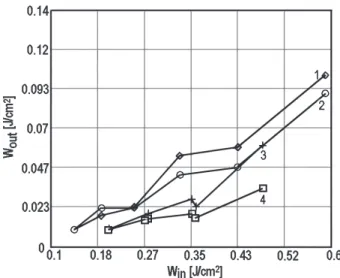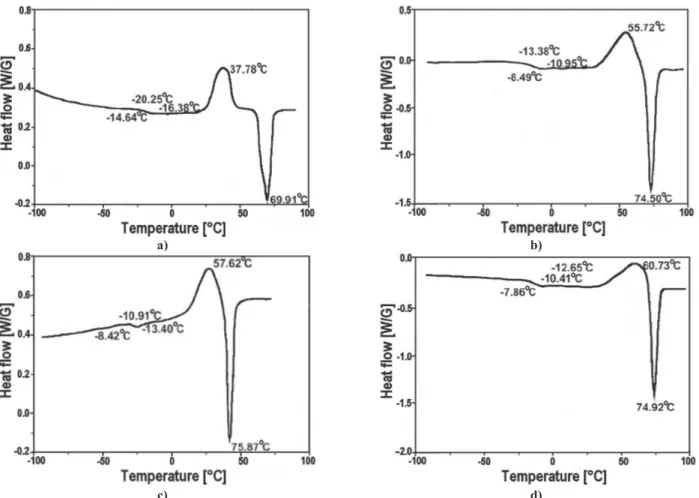229
Processing and Application of Ceramics 5 [4] (2011) 229–231Mechanisms of optical limiting in a COANP solution contaning
fullerenes C
70: Applicability for the optoelectronics devices
#Svetlana V. Likhomanova
1,2,*, Natalie V. Kamanina
1,2,31Vavilov State Optical Institute, Birzhevaya liniya, 12, 199034, St. Petersburg, Russia
2State Institute of Fine Mechanics and Optics, Kronverksky str., 49, 197101, St. Petersburg, Russia 3State Electrotechnical University, Prof. Popova Str., 5, 197376, St. Petersburg, Russia
Received 28 September 2011; received in revised form 7 December 2011; accepted 12 December 2011
Abstract
The mechanisms describing the nonlinear-optical properties of COANP solution sensitized with fullerenes C70 have been described in this work. The data of a DSC technique for pure COANP and system COANP-C70 have been presented. The experimental data regarding the transmission have been shown for the materials treated by laser irradiation.
Keywords: laser-matter interaction, fullerenes, polymer, charge transfer complexes
Fullerenes and carbon nanotubes are widely studied due to their unique properties [1–3]. Composite materials with fullerene and nanotubes can be used to limit a pow-erful laser radiation in the visible and near-infrared spec-tral ranges and to protect human eyes and photosensitive equipment including ceramics. Also fullerenes and nan-otubes can be applied in a solar energy device as a new type of solar battery materials and in medicine to deliv-er medications.
In this paper we are discussing optical limiting prop-erties of 2-cyclooctylamino-5-nitropyridine (COANP) solution containing fullerenes C70. Currently the greatest interest is an investigation of mechanisms leading to the observed nonlinear-optical properties. There are several mechanisms explaining nonlinear-optical properties: re-verse saturable absorption (RSA), photoinduced change in the refractive index, Förster mechanism, complex for-mation, etc.
The 10 mm thick of 1% COANP solution in tetrachlo-rethane sensitized with fullerenes C70 of 0.5, 1.0, 10 and 20 wt.% were investigated. A second harmonic of a pulsed a Nd:YAG-laser radiation (λ = 532 nm) with a pulsewidht of 10 ns was used as a laser source. A diameter of input
la-ser beam was 5 mm. The several neutral ilters were used
to vary the incident energy density. The scheme to treat the samples in order to activate the optical limiting fea-tures was analogous to that presented in the paper [4].
Experiments have demonstrated the limiting of the laser irradiation with energy density from 0.1 J/cm2 to
0.6 J/cm2 (see Fig. 1). We have obtained the maximum
attenuation of the radiation with density energy of 0.35 J/cm2 for the solution COANP-C
70 with fullerene
con-tent of 20 wt.%. The energy value passed through solu-tion has been decreased up to 18 times.
# Paper presented at Conference for Young Scientists - 9th
Students’ Meeting, SM-2011, Novi Sad, Serbia, 2011
* Corresponding author: tel: +7 812 3317550
fax: +7 812 3317558, e-mail: lsv-87@bk.ru
Short Communication
Figure 1. Dependence of the output energy density (Wout) on the input energy density (Win) for COANP with fullerene
230
S.V. Likhomanova & N.V. Kamanina / Processing and Application of Ceramics 5 [4] (2011) 229–231
We are considering RSA and the complex formation as the mechanisms responsible for the optical limiting of COANP-C70 system. The RSA mechanism is based on a difference in cross section for excited and unexcited fuller-ene molecule. The cross section of singlet-triplet excited state in the fullerene is larger than the one of the unexcit-ed molecule. The population of excitation levels increases with laser energy increase, so absorption increases.
The intermolecular charge transfer complex with large
cross section absorption can be formed in π-conjugated
organic system containing C70 due to the large electron
afinity energy of fullerene [5,6]. The electron afini -ty of acceptor fragment in COANP is close to 0.45 eV. This parameter for fullerene is 2.65 eV. To support an evidence of the intermolecular charge transfer complex formation, we present results of DSC analysis (see Fig. 2). One can see that all transition temperature values shift-ing (such as a meltshift-ing point, a point of crystallization and a glass transition temperature) in the case of adding some amount of fullerene C70 in COANP.
It should be mentioned that the DSC results are corre-lated with mass spectrometry data shown previously in the paper [7]. As it has been revealed that mass spectrometry data point out to the formation of the fullerene–HN-group charge transfer complexes (CTCs) for the COANP–C70 system. It has been shown the rate of release of C70 from the sensitized COANP on heating. Two mass spectrometry
peaks have been observed. The irst one, at a temperature
of about 400°C, relates to the release of fragments with the mass of a fullerene molecule. The second peak is shifted to the temperature range from 400°C up to around 520°C and corresponds to the decomposition of HN-group–fullerene complexes. Based on the DSC experiment the shift of the characteristic temperatures to larger temperature region also has been obtained. Thus, CTCs have been supported by DSC method as an additional one.
Conclusions
According to the experimental results the π-conjugated
organic system COANP with C70 could be used in tech-niques and equipments including ceramics as a medi-um for an effective absorption of a laser radiation. The mechanism related to the formation of the intermolecu-lar charge transfer complex has been supported by the re-sults of DSC analysis.
Acknowledgements: The results have been supported by RFBR grant #10-03-00916 and by Russian Federal
Program, Project “Modulator with SEW” (2011).
References
J. Wang, W.J. Blau, “Inorganic and hybrid nanostruc -1.
tures for optical limiting”, J. Opt. A: Pure Appl. Opt.,
11 [2] (2009) 1–16.
Figure 2. DSC analysis of: a) pure COANP (4.00 mg), and COANP with fullerene C70: b) 1.0 wt.% (5.00 mg), c) 2.0 wt.% (5.00 mg) and d) 5.0 wt.% (5.00 mg)
a)
c)
b)
231
S.V. Likhomanova & N.V. Kamanina / Processing and Application of Ceramics 5 [4] (2011) 229–231
N.V. Kamanina, V.N. Sizov, D.I. Stasel’ko, “Recor -2.
ding of thin phase holograms in polymer-dispersed liquid-crystal composites based on
fullerene-contai-ning π-conjugated organic systems”, Opt. Spectrosc.,
90 [1] (2001) 1–3.
T. Hsinhan, X. Zhihua, K. Ranjith, W. Leeyith, A.M.
3.
Dattelbaum, A.P. Shreve, H. Wang, M. Cotlet, “Structu -ral dynamics and charge transfer via complexation with
fullerene in large area conjugated polymer honeycomb thin ilms”, Chem. Mater., 23 [3] (2011) 759–761.
N.V. Kamanina, “Reverse saturable absorption in
4.
fullerene-containing polyimides. Applicability of
the Förster model”, Opt. Commun., 162 [4-6] (1999) 228–232.
N.V. Kamanina, “Fullerene-dispersed nematic liquid
5.
crystal structures: dynamic characteristics and
self-or-ganization processes”, Physics-Uspekhi,48 [4] (2005) 419–427.
N.V. Kamanina, N.A. Shurpo, S.V. Likhomanova, 6.
S.V. Serov, P.Ya. Vasilyev, V.G. Pogareva, V.I.
Stude-nov, D.P. Uskokovic, “Inluence of the Nanostructures on the Surface and Bulk Physical Properties of Mate
-rials”, Acta Physica Polonica A, 119 [2] (2011) 256– 259.
N.V. Kamanina, A.I. Plekhanov, “Mechanisms of op -7.
tical limiting in fullerene-doped π-conjugated organic
structures demonstrated with polyimide and COANP

